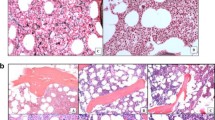Abstract
Anagrelide is a second-line option for reduction of thrombocythemia in patients with chronic myeloproliferative disorders (CMPDs). A multicenter, open, phase II study of anagrelide treatment in 60 patients during 2 yr was performed by the Swedish Myeloproliferative Disorder Study Group. Adequate bone marrow biopsies were obtained from 53 of the CMPD patients [36 essential thrombocythemia (ET), 16 polycythemia vera (PV), 1 chronic idiopathic myelofibrosis (CIMF)] before treatment and compared with biopsies from 30 healthy volunteers and 34 patients with acute myeloid leukemia (AML). Higher reticulin and hyaluronan (HYA) scores were found before anagrelide therapy in the CMPD patients than in the normal controls (p<0.001 and p<0.001, respectively) and AML patients (p<0.001 and p=0.011, respectively). At the end of the study 30 CMPD patients were still on anagrelide treatment and in 19 of these patients, all diagnosed as ET (n=16) or PV (n=3), pretreatment bone marrow biopsies were compared with follow-up samples. After 2 yr of anagrelide therapy the reticulin and HYA scores were significantly higher than before treatment (p=0.02 and p=0.002, respectively). The cellularity was significantly higher (p=0.014), although the number of megakaryocytes did not change significantly. The increase of reticulin and HYA in the bone marrow after 2 yr of treatment with anagrelide indicated progression of fibrosis. Although anagrelide is a valuable drug for reduction of platelet levels, it seems unable to stop progression of bone marrow fibrosis and hypercellularity in ET and PV.
Similar content being viewed by others
References
Ellis JT, Peterson P, Geller SA, Rappaport H. Studies of the bone marrow in polycythemia vera and the evolution of myelofibrosis and second hematologic malignancies. Semin Hematol 1986; 23: 144–155.
Reilly JT. Idiopathic myelofibrosis. Pathogenesis, natural history and management. Blood Rev 1997; 11: 233–242.
Schmitz B, et al. Evidence for integrin receptor involvement in megakaryocyte-fibroblast interaction. A possible pathomechanism for evolution of myelofibrosis. J Cell Physiol 1998; 176: 445–455.
Toole BP. Hyaluronan: from extracellular glue to pericellular cue. Nat Rev Cancer 2004; 4: 528–539.
Heldin P, Laurent TC, Heldin CH. (1989) Effect of growth factors on hyaluronan synthesis in cultured human fibroblasts. Biochem J 1989; 258: 919–922.
Shimabukuro Y, et al. Fibroblast growth factor-2 regulates the synthesis of hyaluronan by human periodontal ligament cells. J Cell Physiol 2005; 203: 557–563.
Sundström G, Löfvenberg E, Hassan I, Engström-Laurent A. Localisation and distribution of hyaluronan in normal bone marrow matrix: a novel method to evaluate impending fibrosis? Eur J Haematol 2002; 68: 194–202.
Sundström G, Dahl IMS, Hultdin M, Lundström B, Wahlin A, Engström-Laurent A. Bone marrow hyaluronan distribution in patients with acute myeloid leukaemia. Med Oncol 2005; 21: 71–78.
Knudson CB. Hyaluronan in embryotic cell adhesion and matrix assembly. In: Laurent TC (ed). The chemistry, biology and medical applications of hyaluronan and its derivatives. Wenner-Gren International Series, Vol. 72, Portland Press, London, United Kingdom, 1998, pp. 161–168.
Anagrelide Study Group. Anagrelide, a therapy for thrombocythemic states: experience in 577 patients. Am J Med 1992; 92: 69–78.
Harrison CN, et al. United Kingdom Medical Research Council Primary Thrombocythemia 1 Study. Hydroxyurea compared with anagrelide in high-risk essential thrombocythemia. N Engl J Med 2005; 353: 33–45.
Birgegård G, et al. Adverse effects and benefits of two years of anagrelide treatment for trombocythemia in chronic myeloproliferative disorders. Haematologica 2004; 89: 520–527.
Pearson T, et al. Polycythemia vera updated: diagnosis, Pathobiology and Treatment. Hematology Am Soc Hematol Educ Program 2000, 51–68.
Kutti J, Wadenvik H. Diagnostic and differential criteria of essential trombocythemia and reactive thrombocytosis. Leuk Lymphoma 1996; 22: 41–45.
Putt F.A. Manual of histological staining methods. John Wiley & Sons: New York, 1972.
Bancroft JD, Stevens A. Theory and practice of histological techniques. 2nd ed. Churchill Livingstone: Edinburgh, 1982.
Tengblad A. Affinity chromatography on immobilized hyaluronate and its application to the isolation of hyaluronate binding proteins from cartilage. Biochim Biophys Acta 1979; 578: 281–289.
Hellström S, Tengblad A, Johansson C, Hedlund U, Axelsson E. An improved technique for hyaluronan histochemistry using microwave irradiation. Histochem J 1990; 22: 677–682.
Bauermeister DE. Quantitation of bone marrow reticulin-a normal range. Am J Clin Path 1971; 56: 24–31.
Yoon SY, Li CY, Mesa RA, Tefferi A. Bone marrow effects of anagrelide therapy in patients with myelofibrosis with myeloid metaplasia. Br J Haematol 1999; 106: 682–688.
Thiele J, Kvasnicka HM, Fuchs N, Brunnbauer K, Volkwein N, Schmitt-Graeff A. Anagrelide induced bone marrow changes during therapy of chronic myeloproliferative disorders with thrombocytosis. An immunohistochemical and morphometric study of sequential trephine biopsies. Hematologica 2003; 88: 1130–1138.
Löfvenberg E, Wahlin A, Roos G, Öst A. Reversal of myelofibrosis by hydroxyurea. Eur J Haematol 1990; 44: 33–38.
Thiele J, et al. Effects of interferon and hydroxyurea on bone marrow fibrosis in chronic myelogenous leukaemia: a comparative retrospective multicentre histological and clinical study. Br J Haematol 2000; 108: 64–71.
Hong Y, Wang G, Del Arroyo AG, Hernandez J, Skene C, Erusalimsky JD. Comparison between anagrelide and hydroxycarbamide in their activities against haematopoietic progenitor cell growth and differentiation: selectivity of anagrelide for the megakaryocytic lineage. Leukemia 2006; 20: 1117–1122.
Hong Y, Erusalimsky JD. Comparison of the pharmacological mechanisms involved in the platelet lowering actions of anagrelide and hydroxyurea: a review. Platelets 2002; 13: 381–386.
Wang G, Franklin R, Hong Y, Erusalimsky JD. Comparison of the biological activities of anagrelide and its major metabolites in haematopoietic cell cultures. Br J Pharmacol 2005; 146: 324–332.
Thiele J, Kvasnicka HM, Ollig S, Schmitt-Gräff A. Anagrelide does not exert a myelodysplastic effect on megakaryopoiesis: a comparative immunohistochemical and morphometric study with hydroxyurea. Histol Histopathol 2005; 20: 1071–1076.
Author information
Authors and Affiliations
Corresponding author
Rights and permissions
About this article
Cite this article
Hultdin, M., Sundström, G., Wahlin, A. et al. Progression of bone marrow fibrosis in patients with essential thrombocythemia and polycythemia vera during anagrelide treatment. Med Oncol 24, 63–70 (2007). https://doi.org/10.1007/BF02685904
Received:
Accepted:
Issue Date:
DOI: https://doi.org/10.1007/BF02685904




